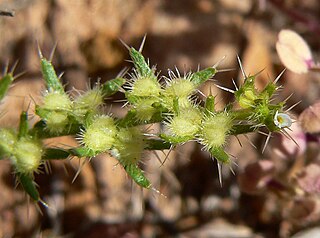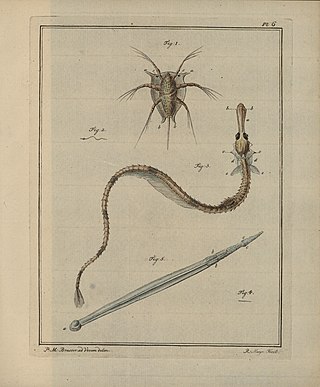The Trinity bristle snail is a species of medium-sized land snail, a terrestrial pulmonate gastropod mollusc in the family Monadeniidae.

Tab-separated values (TSV) is a simple, text-based file format for storing tabular data. Records are separated by newlines, and values within a record are separated by tab characters. The TSV format is thus a delimiter-separated values format, similar to comma-separated values.

The Iris flower data set or Fisher's Iris data set is a multivariate data set used and made famous by the British statistician and biologist Ronald Fisher in his 1936 paper The use of multiple measurements in taxonomic problems as an example of linear discriminant analysis. It is sometimes called Anderson's Iris data set because Edgar Anderson collected the data to quantify the morphologic variation of Iris flowers of three related species. Two of the three species were collected in the Gaspé Peninsula "all from the same pasture, and picked on the same day and measured at the same time by the same person with the same apparatus".

Banchinae is a subfamily of ichneumonid parasitoid wasps containing about 1,500 species; the genera Glypta and Lissonota are very large. The three tribes are all distributed worldwide.

Echeveria setosa, the Mexican fire cracker, is a species of flowering plant in the family Crassulaceae, native to semi-desert areas of Mexico and common throughout Puebla.

Pectocarya setosa, known by the common names moth combseed and round-nut pectocarya, is a species of flowering plant in the borage family.

Alcea setosa, the bristly hollyhock, is an ornamental plant in the family Malvaceae.
Stizocera lissonota is a species of beetle in the family Cerambycidae. It was described by Bates in 1870.
Gorybia lissonota is a species of beetle in the family Cerambycidae. It was described by Martins in 1976.
Mahonia setosa is a shrub in the Berberidaceae described as a species in 1908. It is endemic to China, known from the provinces of Sichuan and Yunnan.

Iris setosa, the bristle-pointed iris, is a species of flowering plant in the genus Iris of the family Iridaceae, it belongs the subgenus Limniris and the series Tripetalae. It is a rhizomatous perennial from a wide range across the Arctic sea, including Alaska, Maine, Canada, Russia, northeastern Asia, China, Korea and southwards to Japan. The plant has tall branching stems, mid green leaves and violet, purple-blue, violet-blue, blue, to lavender flowers. There are also plants with pink and white flowers.

Parasagitta setosa, the coastal arrow worm, is a small arrow worm in the family Sagittidae, previously referred to as Sagitta setosa. It is native to the northeastern Atlantic Ocean, the North Sea and the Mediterranean Sea, and also occurs in the Baltic Sea and the Black Sea.
Callia lissonota is a species of beetle in the family Cerambycidae. It was described by Galileo and Martins in 2002. It is known from Brazil.

Crepis setosa, the bristly hawksbeard, is a European species of flowering plant in the family Asteraceae. It has become naturalized in North America and occurs Washington, Oregon, California, Idaho, Montana, Texas, Arkansas, Missouri, Tennessee, Wisconsin, Ohio, Pennsylvania, New York, Connecticut and Vermont.
Aethrikos is a monospecific genus of ovoviviparous velvet worm, containing the single species Aethrikos setosa. This species has 15 pairs of legs in both sexes. This species exhibits lecithotrophic ovoviviparity; that is, mothers in this species retain yolky eggs in their uteri. The type locality of this species is Styx River State Forest, New South Wales, Australia.

Corymbia setosa, commonly known as rough leaved bloodwood or desert bloodwood, is a species of small tree that is endemic to north-eastern Australia. It has rough, tessellated brown bark on the trunk and branches, a crown of juvenile, heart-shaped leaves arranged in opposite pairs, flower buds in groups of three or seven, white flowers and urn-shaped to shortened spherical fruit.
Triangularia setosa is a member of the Ascomycota, and of the genus Triangularia. This genus is notable for its widespread appearance on the excrement of herbivores, and is therefore seen as a coprophilous fungus. The fungus itself is characteristically dark in colour and produces sac-like perithecium with a covering of hair. Its dispersion involves the ingestion, passage, and projectile ejection of spores. It has preference for colonizing the dung of lagomorphs, such as hares and rabbits.

Macrocoma setosa is a species of leaf beetle found in Algeria and Morocco It was first described by Hippolyte Lucas in 1846, as a species of Pseudocolaspis.
Lissonota impressor is a species of insect belonging to the family Ichneumonidae.
Lissonota fundator is a species of insect belonging to the family Ichneumonidae.










